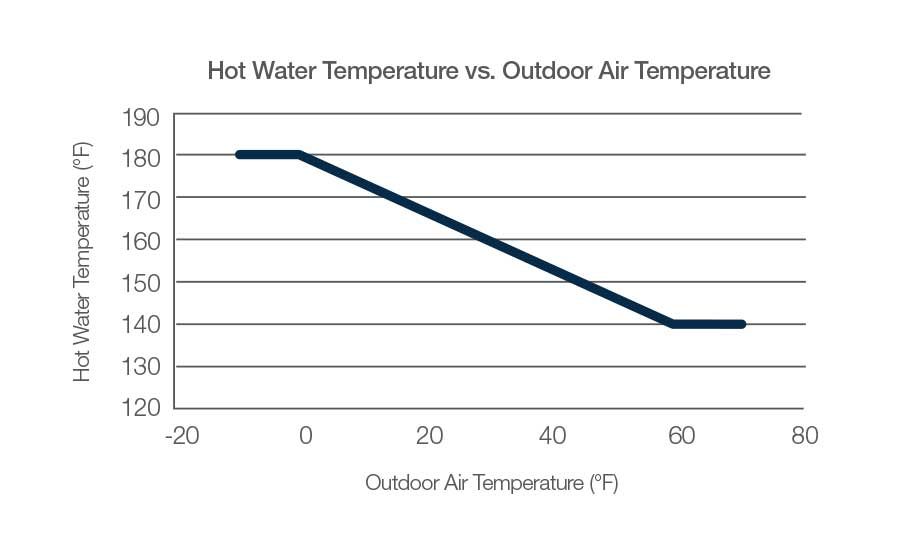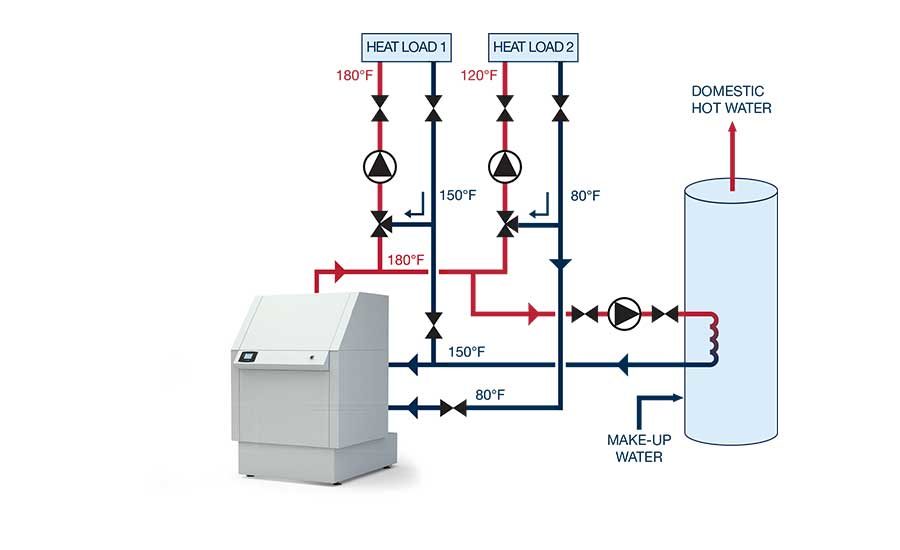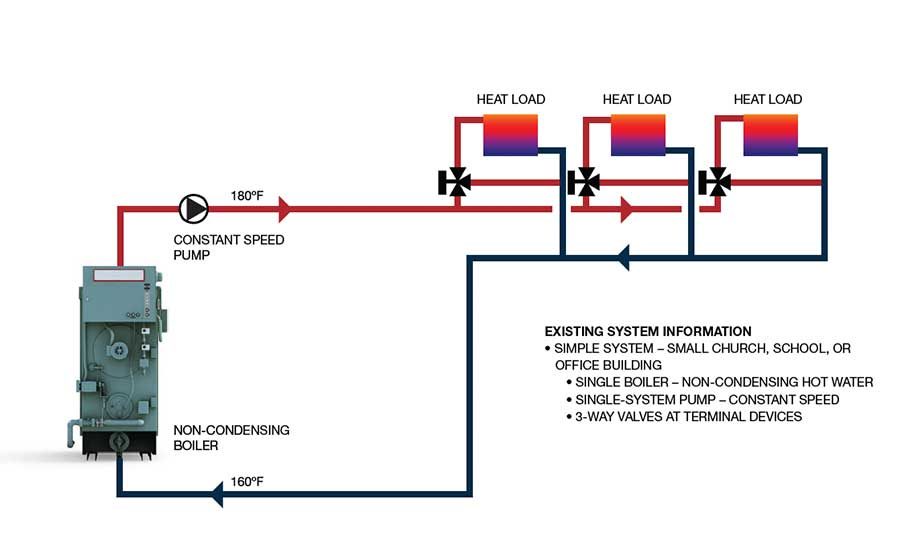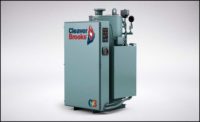As buildings age, so do the major central equipment within the building, making it a prime opportunity for a boiler system retrofit. Older systems typically are made up of non-condensing boilers that operate in the 200ºF to 180°F range with 160ºF to 140°F returns. As boiler designs have advanced to include condensing technology, it is important to understand how to implement condensing boilers into a system to maximize operating efficiencies.
There are many types of hydronic boilers available today, both non-condensing and condensing. Non-condensing boilers are designed to operate with design return water temperatures above 140°F to prevent condensing of the moisture in the flue gases. This is because they are constructed of materials such as carbon steel, cast iron or copper, which are unable to withstand the corrosive condensate produced with condensing.
Non-condensing boilers generally operate with efficiencies less than 87%, with many well below this level. They can also have system piping limitations, both to maintain the minimum return water temperature as well as delta T or minimum flow requirements.
While condensing boilers are more efficient than non-condensing boilers, the latter generally have higher temperature limits, often with higher design-pressure capabilities. In addition, non-condensing boilers are available in larger capacities and often include the capability for a variety of back-up fuels, and their initial equipment cost is often less.
Condensing Boiler Design
Understanding the basics of how condensing boilers are designed and how they should be controlled are the first steps in applying condensing boilers to retrofit applications.
Condensing boilers can achieve efficiencies that exceed 90% because they are designed to operate with cold return water temperatures, which promote condensing of the moisture in the flue gas. In a condensing boiler, the return water must be brought back to the boiler below 130°F — coinciding with the flue gas dew point for natural gas — and the colder the better to maximize condensing. The flue gas dew point is defined as the temperature at which the water vapor present in the flue gas reaches saturation and begins condensing.
Next, the burner must be able to maintain a consistent fuel-air ratio throughout the modulation range of the boiler. This is key for condensing boilers because an increase in excess air leads to a decrease in the flue gas dew point, meaning the return water must be brought back to the boiler even cooler to allow the moisture in the flue gas to condense. The phase change from water vapor to a liquid state releases the latent energy that is to be transferred to the process, which in this case is heating water. The latent heat of vaporization is recovered within the boiler thereby increasing system efficiency.
Finally, the boiler must have an effective heat exchanger design incorporating counter-flow heat exchange to put the coolest flue gases surfaces close to the coolest return water and also have a large amount of fireside heating surface for condensing. The condensate is produced on cold, fireside heating surfaces — the more heating surface that is available, the greater the potential for condensing.
There are two key items that will maximize system performance in a condensing boiler system: a condensing boiler’s inverse efficiency characteristic, and maintaining cold return water temperatures.
Because condensing boilers are more efficient at lower firing rates, it is advantageous to run multiple boilers at lower firing rates to improve overall system efficiency. Since the return water temperature directly impacts a boiler’s efficiency, maintaining the design delta T and keeping the return water temperature as cool as possible are important points to remember when designing a condensing boiler system and control strategy.
Key Steps in a Retrofit
When considering any boiler replacement, it is important to evaluate the system design load, anticipated minimum load, and any redundancy requirements. Changes may have been made to the building and/or system since the original design, and understanding the present load can help ensure the best boiler selection.
Along with the load, it is important to understand the real system supply and return water temperature requirements. If possible, the supply (and return) water temperatures should be reduced as much as possible while still meeting the system heating requirements.
Also, some sort of supply temperature reset strategy should be utilized, most commonly outdoor air temperature reset, which varies the supply temperature setpoint based on anticipated reduced building loads when the weather is warmer. This helps to further decrease the system temperatures, most notably the return water temperature, while still meeting the system requirements.
To help reduce pumping energy and maintain the design delta T in a heating hot water system, it is recommended to utilize variable-speed system pumps, often controlled using differential pressure control — although other pump modulation strategies can be used as well. When evaluating the pumps, also look at the control valves in the system. If the existing system had constant-speed pumps, there are most likely three-way control valves at the terminal devices.
When using variable-speed pumping, the three-way control valves can be converted to two-way control valves, which helps reduce mixing in the return piping and maintains the design delta T. There are several options for converting to variable-speed pumping. In smaller pumps, flow can vary simply by “riding” the pump curve. For larger pumps and to maximize energy savings, VFDs or ECM motors can be used.
The flue system and combustion-air supply must also be evaluated when retrofitting a non-condensing boiler system to a condensing boiler system. Non-condensing boilers generally use a Category I or III venting product, which is not designed to handle the corrosive condensate produced with condensing boilers. Non-condensing boilers often use room air for combustion air, while condensing boilers may offer the opportunity to direct vent or duct the combustion air from the outside directly to the boiler. When switching to condensing boilers, it is best to utilize a UL-listed Category IV venting product that is designed for use with condensing boilers. Masonry chimneys often need to be lined with a Category IV liner to protect the masonry from the condensing flue gases.
Many condensing boilers utilize what is known as premix burner technology. While excellent for condensing boilers, these burners can be more sensitive to inconsistent gas pressures compared to older-style burners. Due to this, it is important to review what the site gas pressure is and ensure that the gas headers are appropriately sized for the boiler requirements.
Overall, condensing boilers generally require less maintenance than non-condensing boilers; however, they also produce acidic condensate that must be treated before it discharges to the drain to protect the drain from damage. The most common form of treatment is a condensate treatment tank or tube that contains a neutralizing media to raise the pH of the condensate close to neutral. The condensate discharge from the tank or tube must be checked periodically as part of regular boiler room maintenance to make sure the neutralizing media is doing its job. Over time, the media will need to be replaced.
Types of Condensing Boilers
There are many condensing boiler types and technologies available. Condensing boilers can be constructed of different materials, typically stainless steel or cast aluminum, and have varying operational requirements. Low-mass condensing boilers, defined as having 20 gallons per 1,000 MBH or less of water volume, often require constant flow rates, while high-mass boilers with 50-gallons per 1,000 MBH or more of water volume are generally low-flow tolerant.
Low-mass designs typically have high waterside pressure drops necessitating a primary-secondary pumping system. High-mass boilers often have much lower pressure drops, making them ideal for variable-flow primary pumping systems.
Condensing boilers also can vary widely in their effective heating surface, heat exchanger arrangements, and burner technologies. Therefore, understanding the boiler selection criteria is key to ensure a successful retrofit project.
Several high-mass condensing boilers offer dual-return connections as standard. Dual returns are advantageous in retrofit situations because they can condense when a small amount (generally 10% or greater) of return water is brought back to the boiler as a separate loop, with a temperature below 130°F. When connected to the lower temperature return instead of mixing in the system piping, the coldest possible water is introduced to the boiler thereby increasing the condensing potential and fuel efficiency of the system.
When a higher temperature return connected at a warmer location of the heat exchanger combines with the low-temperature return located near the coolest flue gases, the boiler can achieve condensing performance even when a majority of the system requires operation at non-condensing temperatures.
This application can work well for legacy systems that require a higher design-day temperature, but may have another load available that can operate at lower temperatures. Examples of low-temperature opportunities include pool heating, domestic hot water, snow melt, and outside air heating coils, among others.
Finally, it is important to understand a condensing boiler’s requirements with respect to piping and flow rates. Since there are a variety of condensing boilers available, be sure to refer to the manufacturer’s requirements for piping and operation. Typically, low-mass condensing boilers require constant flow or high minimum-flow rates. High-mass boilers often have very low minimum-flow requirements and are considered low-flow tolerant.
With their large volume of water, high-mass boilers can withstand varying flow conditions without issue. This is important to remember when evaluating how to pipe the new boilers. Low-mass boilers will require primary-secondary piping and potentially a buffer tank to add system volume. High-mass boilers can be piped in a variable-flow primary arrangement to maximize overall system efficiency from both a boiler-efficiency and pumping-energy standpoint.
Retrofit Scenarios
The following are three retrofit scenarios, ranging from simple to more complex.
First, consider a small, single-boiler system often seen in a church or school. The existing system is non-condensing with a constant-speed pump and three-way control valves. To maximize the condensing boiler’s efficiency, the system temperatures should be evaluated and lowered, if possible, either year-round or by implementing supply temperature reset. The three-way control valves should be replaced with two-way control valves, while maintaining enough three-way control valves for the minimum-flow requirements in order to take advantage of variable-speed pumping. This will reduce pumping energy as well as maintain a lower return water temperature back to the condensing boiler.
An intermediate-sized system, often found in a larger school, office building, or hotel, typically consists of two to three boilers with dedicated, constant-speed boiler pumps and three-way valves at the system terminal devices. There are two phases to this retrofit.
Initially, one non-condensing boiler will be replaced with a high-mass condensing boiler. At low-load conditions, the condensing boiler will utilize outside air reset to reduce the system temperatures and improve efficiency. At higher loads, the non-condensing boiler will be the lead boiler, and the condensing boiler will be the lag boiler. In this condition, the system setpoint will be higher in non-condensing mode since the load is greater based on colder outside-air conditions. This strategy could be accomplished with manual control, building management system programming, or a packaged hybrid controller.
In Phase II, the remaining legacy boiler will be replaced with a second (or third) condensing boiler, and the system will be converted to full variable-flow primary. At the same time, the three-way valves will be converted to two-way control valves, outside air reset can be used, and a condensing control strategy with multiple boilers operating at lower firing rates in parallel can be implemented.
Lastly, consider a large system retrofit where there are multiple large boilers in a primary-secondary arrangement. For this system, there are a variety of options that can be explored depending on project budget and the condition of the legacy boilers, along with the other items discussed previously.
The first option is to pipe the condensing boilers upstream of the three-way mixing valve, allowing the condensing boilers to see the coolest return water from the system. This would enable one or all non-condensing boilers to remain for design days or redundancy.
Another option is to replace all non-condensing boilers with condensing ones and convert the system to variable-flow primary.
The final option is to design a full hybrid plant with the condensing boilers piped in a variable-flow primary arrangement, and the legacy non-condensing boiler(s) in a primary-secondary arrangement for use on design days or as back-up boilers.
There are a few key points to remember for all retrofit applications. First, always work with the boiler manufacturer to design a system that will perform best with the equipment while providing the most efficient, reliable operation. Within the condensing boiler segment, there are a variety of boiler technologies, each with different operating requirements. Understanding the operating requirements during the design phase will ensure proper implementation of the respective boiler model.
From a system standpoint, it is crucial to understand the building load and to lower the return water temperature to the boiler whenever possible. Eliminate three-way control valves when transitioning to variable-flow pumping so the coldest possible water is returned to the boilers. When practical, implement high-mass condensing boilers in a variable-flow primary arrangement to eliminate the mixing inherent in the decoupler between the primary and secondary loops at part-load conditions. Again, this results in the boilers receiving the coldest return water possible.
To realize condensing efficiencies, lower the system setpoint year-round or implement supply temperature reset as needed. If there is the ability to bring back a portion of the return water below condensing temperatures, adding a dual return into the system can improve operational efficiencies, even if the entire building cannot support condensing temperatures.
To understand the inverse efficiency characteristic of condensing boilers, it is important to control the condensing boilers in parallel modulation with multiple boilers operating at lower firing rates to obtain the highest possible operating efficiencies of the hot water heating system.












